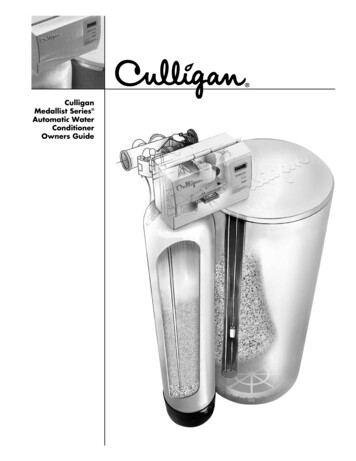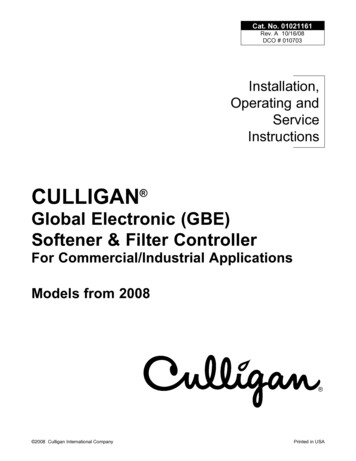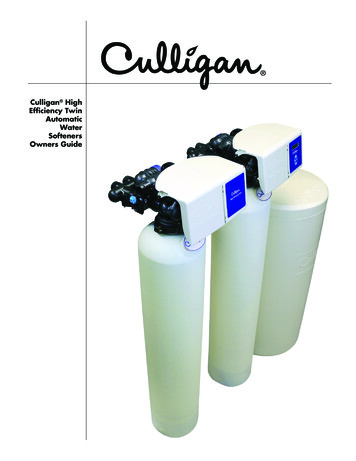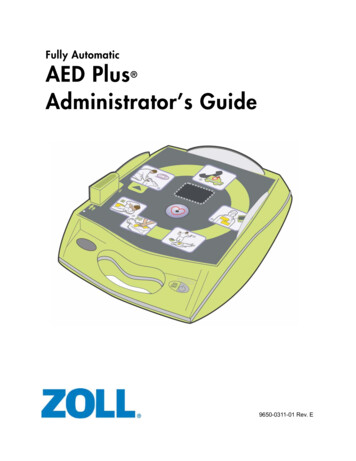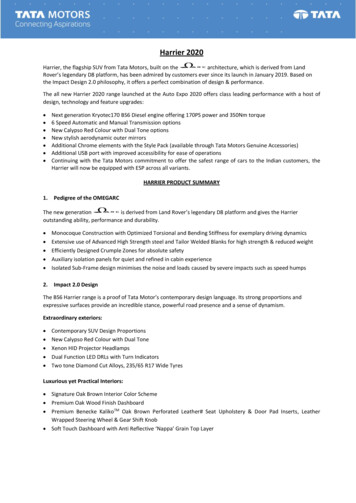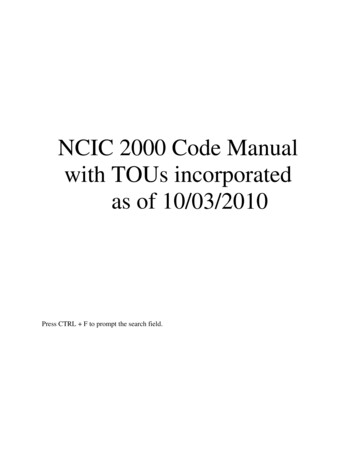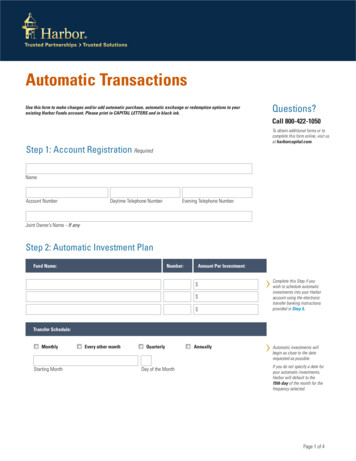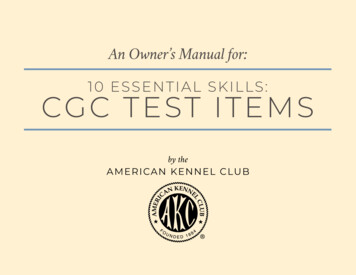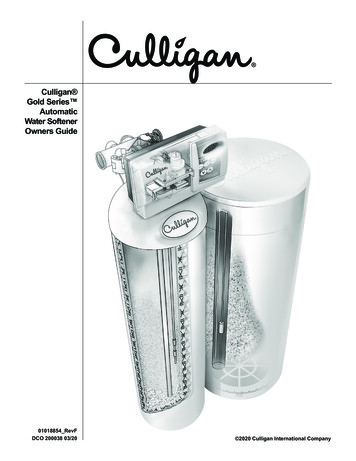
Transcription
Culligan Gold Series AutomaticWater SoftenerOwners Guide01018854 RevFDCO 200038 03/20 2020 Culligan International Company
This page intentionally left blank.201018854 F 02/20
About this Manual 4Thank You.5Specifications 6Introduction.7How Your Water Softener Works 8Component Description 9The Culligan Process 10Modes of Operation 11Salt Supply, Usage and Service 12Care and Cleaning of Your Water Softener 13Cleaning Out the Salt Storage Tank 14ContentsPerformance DataSheets are included inthis manual for variousCulligan Gold Series Softener models. Referto the PerformanceData Sheet for yourspecific softener,as there are slightdifferences betweenthe models. Thesoftener warranty islocated on page 37of this Owner’s Guide.Programming.15Regeneration.16Error Codes.17When and How to Bypass Your Water Softener 18Things to Check Before You Call for Service 19Parts List Gold Series Softener Valve 20Parts List Power Valve Service Parts List 21Parts List Tank Assembly 24Parts List 11” Brine System 25Parts List 16” and 18” Brine Systems 26Parts List 24” Brine System 27Parts List Brine Valve 28Performance Data Sheet Culligan Gold 9” Soft-Minder 29Performance Data Sheet Culligan Gold 9” Aqua-Sensor 30Performance Data Sheet Culligan Gold 10” Soft-Minder 31Performance Data Sheet Culligan Gold 10” Aqua-Sensor 32Performance Data Sheet Culligan Gold 12” Soft-Minder 33Performance Data Sheet Culligan Gold 12” Aqua-Sensor 34Performance Data Sheet Culligan Gold 14” Soft-Minder 35Performance Data Sheet Culligan Gold 14” Aqua-Sensor 36Culligan Limited Warranty 3701018854 F 02/203
About thisManualRead this Manual FirstBefore you operate the Gold Series Water Softening System, read this manual to becomefamiliar with the device and its capabilities.NOTE:This system must be supplied with COLD WATER only.Watch for Special ParagraphsPlease read the special paragraphs in this manual. Examples are shown below.Safe PracticesThroughout this manual there are paragraphs set off by special headings.Notice (or Note) is used to emphasize installation, operation or maintenance informationwhich is important, but does not present any hazard. Examples:NOTE:NOTICECheck and comply with your state and local codes. You mustfollow these guidelines. For installations in Massachusetts,Massachusetts Plumbing Code 248 CMR shall be adhered to.Consult your licensed plumber for installation of this system.This system and its installation must comply with state and localregulations. The use of saddle valves is not permitted.The nipple must extend no more than 1 inch above the cover plate.Caution is used when failure to follow directions could result in damage to equipment or property. Example:CAUTION!Disassembly while under water pressure can result in flooding.Warning is used to indicate a hazard which could cause injury or death if ignored. Example:WARNING! Electrical shock hazard!Unplug the unit before removing the timer mechanism or cover plates!Serial NumbersThe control valve serial number is located on the back of the electrical enclosure.The media tank serial number is located on the top surface of the tank.This publication is based on information available when approved for printing.Continuing design refinement could cause changes that may not be included in this publication.NOTE:DO NOT remove or destroy the serial number.It must be referenced on request for warranty repair or replacement.Products manufactured and marked by Culligan International Company (Culligan) and its affiliates areprotected by patents issued or pending in the United States and other countries. Culligan reserves theright to change the specifications referred to in this literature at any time, without prior notice.4Culligan, Aqua-Sensor, Tripl-Hull, Flo-Pak and Soft-Minder are trademarks ofCulligan International Company or its affiliates.01018854 F 02/20
Welcome To Your New World of Better Living with Culligan Water.Thank YouThe Culligan Gold Series Water Softeners with Soft-Minder Meter andAqua- Sensor sensing device are tested and certified by WQA against NSF/ANSI 372, CSA B483.1, and NSF/ANSI Standard 44 for the effective reductionof hardness (calcium and magnesium), barium and radium 226/228 as verifiedand substantiated by test data.The Culligan Gold Series Water Softeners with Soft-Minder Meter andAqua- Sensor sensing device are tested and certified by WQA against NSF/ANSI Standard 61 for material requirements.The Culligan Gold Series Water Softeners with Soft-Minder Meterand Aqua- Sensor sensing device are certified by IAPMO R&T againstNSF/ ANSI 372, CSA B483.1, and NSF/ANSI Standard 44 for the effectivereduction of hardness (calcium and magnesium), barium and radium226/228 as verified and substantiated by test data.The Culligan Gold Series Water Softeners with Soft-Minder Meter andAqua- Sensor sensing device are certified by IAPMO R&T against NSF/ANSI Standard 61 for material requirements.The Culligan Gold Series is also registered with the State of Californiaand the State of Iowa.For installations in Massachusetts, the Massachusetts Plumbing Code 248 CMR shall be adheredto. Consult your licensed plumber for installation of this system. This system and its installationmust comply with state and local regulations. The use of saddle valves is not permitted.If this is your first experience having soft, conditioned water in your home, you’ll be amazedat the marvelous difference it makes. We promise that you’ll never want to be without it again.Congratulations, too, on selecting one of the “first family” of water softeners in the prestigiousCulligan Gold Series. With Culligan’s many years of knowledge and experience in water treatment,you can be confident that the model you selected has been designed and engineered to provideyears of service with a minimum of care and attention.Some localities have corrosive water. A water softener cannot correct this problem and so its printedwarranty disclaims liability for corrosion of plumbing lines, fixtures or appliances. If you suspectcorrosion, your Culligan Dealer has equipment to control the problem.NOTICESodium Information: Water softeners using sodium chloride for regeneration addsodium to the water. Persons who are on sodium restricted diets should considerthe added sodium as part of their overall sodium intake.Attention Culligan Customer:The installation, service and maintenance of this equipment should be rendered by a qualified andtrained service technician. Your local independently operated Culligan dealer employs trained serviceand maintenance personnel who are experienced in the installation, function and repair of Culliganequipment. This publication is written specifically for these individuals and is intended for their use.We encourage Culligan users to learn about Culligan products, but we believe that product knowledgeis best obtained by consulting with your Culligan dealer. Untrained individuals who use this manualassume the risk of any resulting property damage or personal injury.01018854 F 02/205
SpecificationsCulligan Gold Series Water Softeners with Aqua-Sensor Deviceor Soft-Minder MeterModelControl ValveOverall Softener HeightMedia Tank Design12” Model14” Model1” 5-cycleReinforcedThermoplastic1” 5-cycleReinforcedThermoplastic1” 5-cycleReinforcedThermoplastic54 in60 in58 in71 inQuadra-HullQuadra-HullQuadra-HullQuadra-Hull9 x 48 in10 x 54 in12 x 52 in14 x 65 inSalt Storage Tank Dimensions(Dia x Ht)16 x 43 in18 x 43 in18 x 43 in24 x 42 inCullex Media,1.0 ft3Cullex Media,1.5 ft3Cullex Media,2.0 ft3Cullex Media,3.0 ft3Cullsan Underbedding, 12 lbCullsanUnderbedding,15 lbCullsanUnderbedding,16 lbCullsanUnderbedding,25 lb19,086 gr @ 4.0 lb28,629 gr @ 6.0 lb35,614 gr @ 8.0 lb53,540 gr @12.0 lb26,301 gr @ 8.0 lb39,451 gr @12.0 lb50,189 gr @16.0 lb77,660 gr @24.0 lb30,787 gr @12.0 lb46,180 gr @18.0 lb60,384 gr @24.0 lb90,986 gr @36.0 lb4,770 gr/lb @4 lb salt dosage4,770 gr/lb @6 lb salt dosage4,450 gr/lb @8 lb salt dosage4,460 gr/lb @12 lb salt dosage14.5 in14.5 in20 in25 inUnderbedding, Type and QuantityExchange Capacity @ SaltDosage Per RechargeEfficiency at rated salt dosage1, 6Freeboard to Media2Freeboard to Underbedding344.5 in47.5 in46 in59 in250 lb or 375 lb375 lb375 lb600 lbRated Service Flow@PressureDrop9.0 gpm @ 14 psi9.5 gpm @ 15 psi10.0 gpm @ 11 psi10.6 gpm @11 psiAuxiliary Service Flow @Pressure Drop9.0 gpm @ 14 psi9.5 gpm @ 15 psi10.0 gpm @ 11 psi10.6 gpm @ 11 psiTotal Hardness, Maximum75 gpg99 gpg99 gpg99 gpgSalt Storage CapacityTotal Iron, Maximum5 ppm5 ppm5 ppm5 ppm8 gpg to 1 ppm8 gpg to 1 ppm8 gpg to 1 ppm8 gpg to 1 ppmOperating Pressure20-125 psi20-125 psi20-125 psi20-125 psiOperating Pressure (Canada)20-90 psi20-90 psi20-90 psi20-90 psiHardness to Iron Ratio, Min.Operating Temperature33-120 F33-120 F33-120 F33-120 FElectrical Requirements24V/60 Hz24V/60 Hz24V/60 Hz24V/60 Hz3 Watts/ 35 Watts3 Watts/ 35 Watts3 Watts/ 35 Watts3 Watts/ 35 Watts6.6 gpmElectrical Power Consumption,Min/MaxDrain Flow, Maximum401018854 F 02/2010” Model1” 5-cycleReinforcedThermoplasticMedia Tank Dimensions(Dia x Ht)Exchange Media, Type andQuantity69” Model1.6 gpm1.6 gpm2.6 gpmRecharge Time, Average568 min57 min52 min66 minRecharge Water Consumption,Average535 gal46 gal51 gal176 gal1 The efficiency rated dosage is only valid at the 4 lb. salt dosage for the 9” model, 6 lb. salt dosage for the 10” model, 7 lb. saltdosage for 12” model and 12 lb. salt dosage for 14” model and is efficiency rated according to NSF/ANSI Standard 44.2 Measured from top of media to top surface of tank threads (backwashed and drained).3 Measured from top of underbedding to top of inlet fitting.4 Backwash at 120 psi (830 kPa).5 10 minute backwash, 4 lb. (1.8 kg) 9” model, 6 lb. (2.7 kg) 10” model, 7 lb. 12” model or 12 lb. 14” model salt dosage at 30 psi (204 kPa).
It’s All So Easy, So Economical, So Efficient, So Enjoyable!Kind To Skin And ComplexionIntroductionSoft water will help prevent red, itchy or dry skin because there are no hardness impurities to causesoreness, no soap curd to coat the skin. Shaving is easier, smoother—either with a blade or electric shaver.Bathing And ShoweringYou’ll use far less soap with conditioned water. Use your soap very sparingly—not as you did before softwater. Just a quick rinse removes all lather, leaving your skin pleasantly smooth and silky because nowit’s free of sticky soap curd and film.Saves Washing Costs. Helps Control Environmental PollutionSoft water washes whiter and cleaner with less soap or detergent. Because the hardness impurities areremoved, your soap can concentrate solely on washing. People usually find that they can reduce theamount of soap they use substantially. If you normally use a cup per wash load with hard water, try using1/3 cup depending on the size of your wash load and the degree of soil. Different amounts are required, butyou can use less with softened water. An added bonus is the fact that your washable fabrics will last longer.Super Hair ConditioningSoft water is great for scalp and hair care. No insoluble deposits are formed. Hair is shinier, softer,more manageable. Reduce the amount of shampoo you have normally used.Dishes Are A DelightWashed by hand or in a dishwasher, glassware, dishes and silver wash cleaner, easier. Follow yourdishwasher manufacturer’s instructions. Soft water promotes sanitation because no greasy hard waterfilm can form to collect or harbor bacteria.Easier Housekeeping, Gleaming FixturesYou’ll be amazed at the marvelous difference. Just a swish of the cloth, and the bathtub or shower andfixtures are clean and sparkling. Imagine, no scouring! No hard water scum to cause rings, streaks, spotsand stains. To keep their gleaming luster, simply wipe fixtures with a towel after use. Formica, tile, walls,floors, woodwork surfaces clean easier, stay clean longer. You’ll save on cleaning aids and save on time.Saves Water-Heating Energy, Helps Water-Using AppliancesSoft water reduces the formation of rock-like hard water scale that encrusts water heaters, hot water pipes,shower heads, and water-using appliances. This scale can cause premature maintenance and failure.Elimination of hard water also provides substantial energy savings because scale acts as an insulator,wasting electricity or gas used to heat water.Water For Lawns And Household PlantsIf possible, lawn sprinkling faucets should be supplied with hard water primarily because it is noteconomical to soften so much water.Household plants are much more sensitive than lawns with respect to the kind of water which is best. First,because they receive no rainfall and, second, there is little or no drainage of the soil. Preferably they shouldbe watered with rainwater or water which is low in mineral content such as distilled or demineralized water.Softened water is not recommended for house plants because a build-up of sodium in the soil may interferewith efficient absorption of water by the plant root system. Additional information may be obtained from yourindependently operated Culligan dealer.Culligan Total HomeWith the Culligan Total Home you will experience the above benefits in additionto the reduction of chlorine taste and odor for a fresh, clean taste and smell.01018854 F 02/207
How YourWater SoftenerWorksWhy Water Gets Hard And How It’s SoftenedAll of the fresh water in the world originally falls as rain, snow, or sleet. Surface water is drawnupward by the sun, forming clouds. Then, nearly pure and soft as it starts to fall, it begins to collectimpurities as it passes through smog and dust-laden atmosphere. And as it seeps through soil androcks it gathers hardness, rust, acid, unpleasant tastes and odors.Water hardness is caused primarily by limestone dissolved from the earth by rainwater. Because ofthis, in earlier times people who wanted soft water collected rainwater from roofs in rain barrels andcisterns before it picked up hardness from the earth.Some localities have corrosive water. A softener cannot correct this problem and so its printedwarranty disclaims liability for corrosion of plumbing lines, fixtures or appliances. If you suspectcorrosion, your Culligan Man has equipment to control the problem.Iron is a common water problem. The chemical/physical nature of iron found in natural watersupplies is exhibited in four general types:1.Dissolved Iron - Also called ferrous or “clear water” iron. This type of iron can be removedfrom the water by the same ion exchange principle that removes the hardness elements,calcium and magnesium. Dissolved iron is soluble in water and is detected by taking a sampleof the water to be treated in a clear glass. The water in the glass is initially clear, but onstanding exposed to the air, it may gradually turn cloudy or colored as it oxidizes.2.Particulate Iron - Also called ferric or colloidal iron. This type of iron is an undissolvedparticle of iron. A softener will remove larger particles, but they may not be washed out inregeneration effectively and will eventually foul the ion exchange resin. A filtering treatmentwill be required to remove this type of iron.3.Organic Bound Iron - This type of iron is strongly attached to an organic compoundin the water. The ion exchange process alone cannot break this attachment and thesoftener will not remove this type of iron.4.Bacterial Iron - This type of iron is protected inside a bacteria cell. Like the organic boundiron, it is not removed by a water softener.When using a softener to remove both hardness and dissolved iron it is important that it regenerates morefrequently than ordinarily would be calculated for hardness removal alone. Although many factors andformulas have been used to determine this frequency, it is recommended that the softener be regeneratedwhen it has reached 50 - 75% of the calculated hardness alone capacity. This will minimize the potential forbed fouling. (Iron removal claims have not been verified by the Water Quality Association.)If you are operating a water softener on clear water iron, regular resin bed cleaning is needed to keep the bedfrom coating with iron. Even when operating a softener on water with less than the maximum of dissolved iron,regular cleanings should be performed. Clean every six months or more often if iron appears in your conditionedwater supply. Use resin bed cleaning compounds carefully following the directions on the container.NOTICE801018854 F 02/20Do not use where the water is microbiologically unsafe or with water ofunknown quality without adequate disinfection before or after the unit.
The water softener is shipped from the factory in a minimum of three cartons.Remove all components from their cartons and inspect them before starting installation.Control Valve Assembly - Includes the regeneration control valve and the Accusoft Plus circuit board.Small parts packages will contain additional installation hardware, and the Softener Owner’s Guide.ComponentDescriptionMedia Tank - Includes Quadra-Hull media tank complete with Cullex ion exchange resin,underbedding and outlet manifold (12” and 14” tanks are shipped without media).Salt Storage Tank Assembly - Includes salt storage container with support plate and Dubl-Safe brine refill valve and chamber.Bypass Valve - Includes the molded bypass valve, the interconnecting couplings, and the assembly pins.Refer to Figure 1 for system placement. Set the media tank on a solid, level surface near water, drain and electrical facilities.Set the brine system on a flat, smooth, solid surface as near the media tank as possible.Tank Assembly 9” and 10” tanks are filled with media at the factory. Before the unit can be connected to the plumbing the manifold must be inserted and medialoaded into the tank for 12” and 14” units.CAUTION!Do not lay the tank down unless a suitable lifting device is available.Personal injury and damage to the unit can result if dropped.Position the Mineral Tank(s)Determine the location for the mineral tanks(s) prior to loading, since they will be difficult to moveafter the underbedding and gravel are loaded.NOTE:Air gap 2x pipe diameter or 1 inch diameter, whichever is larger.Figure 1.Positioning the Tank01018854 F 02/209
The CulliganProcessYour Culligan water softener consists of threebasic components, (A) the Control Valve, (B) theMineral Tank, and (C) the Brine System.A.The exclusive Culligan control valveautomatically performs a variety of tasks thatare necessary for the proper operation ofyour water softener. These tasks, commonlyreferred to as cycles or operating positions,are Service, Regeneration, and Brine Refill.1.B.Service: While the control valve is in the“Service cycle”, hard water is directeddown through the column of Cullex resinwhere hardness minerals are removedfrom the water. The softened wateris then directed into your householdplumbing lines. The ability of the Cullexresin to remove hardness minerals needsto be periodically replenished; this isreferred to as Regeneration.Figure 2.2.Regeneration: While the control valve is in the “Regeneration cycle”, water is first directed upthrough the column of Cullex resin to flush accumulated sediment out of the resin and down thedrain. Then, the regenerant brine solution is slowly drawn from the bottom of the salt storagetank of the Brine System and is directed down through the column of Cullex resin, restoring theability of the resin to remove hardness minerals from your water supply. Once completed, theregeneration cycle is followed by Brine Refill.3.Brine Refill: While the control valve is in the “Brine Refill cycle”, a predetermined amountof water is directed to the salt storage tank of the Brine System so that additional salt can bedissolved to provide the brine solution that will be needed for the next regeneration cycle.The Mineral Tank contains the Cullex resin column, Cullsan underbedding, and an outlet manifold(the Culligan Total Home also includes carbon media for chlorine taste & odor reduction). The numberof gallons of hard water that can be softened by the Cullex resin column before it needs regenerationis called the “capacity” of the resin column, and depends upon the amount of hardness mineralsin each gallon of water (expressed as grains per gallon) and upon the amount of regenerant brinesolution (expressed as pounds of salt) passed through the resin column during regeneration.Your Culligan service person, taking into account the hardness of your water and the amount ofsoftened water your household may reasonably expect to use each day, has carefully establishedhow often the softener will regenerate and how much salt will be used for each regeneration.This will ensure that all of your soft water needs will be fulfilled without using an excessive amount of salt.C. The Brine System consists of a salt storage container and hydraulic Dubl-Safe valve.The salt storage container holds the salt that is used to make the regenerant brine solution.The hydraulic Dubl-Safe valve limits the amount of water that is returned to the salt storagetank during the brine refill cycle.Since a predetermined amount of salt is dissolved with each brine refill cycle, the salt must be periodicallyreplenished in order to maintain efficient operation. Your Culligan service person will be able to tell youabout how often salt must be added to the salt storage container.1001018854 F 02/20
Water Meter ModeIn water meter mode, the controller keeps track of the quantity of water that has flowed through theresin bed. Based on the influent water hardness and the hardness capacity of the resin bed, a servicelife expectancy in the quantity of softened water is calculated and programmed into the control. Whenthe set point is reached, regeneration is triggered. In delay regeneration mode, if the predict mode isturned on, the average daily water usage will be compared to the remaining capacity at the regenerationdelay time to predict if another day’s water usage can occur before requiring regeneration. If enoughcapacity is not present then the regeneration will occur at that time. If the predict mode is not selectedthe regeneration will start at time of regeneration. In immediate mode the regeneration starts when thecapacity is exhausted. If time clock backup is set and the capacity has not been exhausted but the dayssince last regen is greater than time clock backup, setting the softener will immediately regenerate.Modes ofOperationAqua-Sensor ModeThe Aqua-Sensor is a conductivity probe that senses when a hardness front passes through the resinbed. It functions independently of the influent water hardness so therefore, is useful in conditionswhen the influent water hardness varies throughout the year. It provides for the most efficient mode ofoperation. In addition to sensing when a resin bed is exhausted, it can also be used to determine whenthe brine solution is rinsed from the resin bed during the Brine Draw/Slow Rinse cycle triggering thecontrol to move to fast rinse. This patented feature provides water savings by optimizing the amount ofrinse water required to completely rinse out the resin bed.Manual RegenerationPressing and holding the regen button for 5 seconds will initiate an immediate regeneration.The beeper will give one beep at the start of manual regeneration (when the motor starts to turn).In delay mode, pressing and releasing the regen button will light the regen icon for regeneration tooccur at the set delay time. Pressing and releasing the regen button again will turn off the regen icon.Predict ModeThe Predict Mode is used with the flow meter to determine the optimum regeneration point. Beforethe regeneration starts, the control will compare the remaining capacity value with the average dailywater use. If the average daily water usage is less than the reserve capacity, the controller will wait 24more hours before regeneration. If the reserve capacity is less than the average daily water usage, thecontrol will initiate regeneration. This works in delay mode only. At any time, if the total capacity value isreached, the control will initiate an immediate regeneration.Efficiency ModeWater softeners historically use an optimum time range to control the Regeneration cycle steps,with a minimum and maximum time required to perform each step dependent on the salt being used,the hardness total and iron level. Culligan typically uses the maximum time range to insure effectiveRegeneration. However, if the iron content of the water to be softened is zero, and the hardness level isless than 20 gpg, Culligan has developed a new set of regeneration times geared to reducing salt andwater usage. These times are defined under a new operating mode coined “Efficiency Mode”. Comparedto the present time values used, these new regeneration times and salt dosages are considerably less.01018854 F 02/2011
Salt Supply,Usage andServiceSalt is the mineral used to “recharge” your water softener. A brine solution is automatically madeup in the bottom of the salt storage container, the Cullex resin beads in the mineral tank areflushed with the brine solution as a step in the recharging process.Your Culligan Water Softener has been carefully designed to get the greatest amount of softeningcapacity from the salt it uses. Here is some pertinent information about salt usage, types and service.Salt EconomizerThis control is set at the time of installation, and determines salt usage according to the waterhardness, number of persons in the household, and water usage.What Kind of Salt is BestAll Culligan Water Softeners are designed to use any water softener salt of good quality,including rock, pellet, solar, or “evaporated” types.All rock salt, regardless of source, contains insoluble material which collects at the bottomof the salt storage tank and requires periodic clean-out.If purified salt products are used, the salt storage compartment will require less frequentclean-out, but you must check more frequently for “bridging.”Regardless of what type of salt is used, we recommend Culligan Brand Salt as suggestedby your Culligan Dealer. He or she is the expert and can provide you with the best productfor your Culligan Water Softener.Automatic Salt Delivery ServiceAsk your Culligan Dealer for details about salt delivery service. You can have your salt supplyreplenished on a regular basis. Whether you have automatic delivery service or pick up saltfrom your Culligan Dealer, you will be getting quality salt packaged according to rigid Cull
6 01018854 F 02/20 Culligan Gold Series Water Softeners with Aqua-Sensor Device or Soft-Minder Meter Model 9" Model 10" Model 12" Model 14" Model Control Valve 1" 5-cycle Reinforced Thermoplastic
